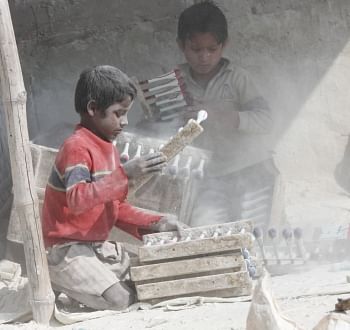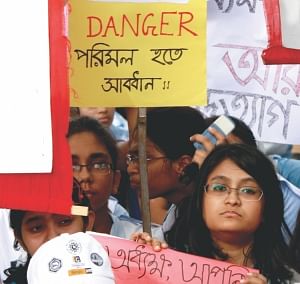| Home - Back Issues - The Team - Contact Us |
 |
| Volume 10 |Issue 34 | September 09, 2011 | |
|
|
Letters Are Laws Enough to Stop Child Labour?
Child labour has been one of the most discussed issues for quite a long time. Many international organisations including the UN and some leading NGOs consider child labour as exploitative and inhuman. The Bangladesh Labour Act prohibits children under the age of 14 from working. Moreover, the Employment of Children Act, 1938,prohibits children under 12 from working in industries and prohibits children under 15 from working in railways. But unfortunately, there are no specific laws covering the informal sectors such as agriculture and domestic work, although the majority of child workers fall into these categories. So firstly the laws prohibiting child labour are very limited in terms of the categories of work they do. But now the question is, even if there are so many existing laws and organisations working against child labor, why are the number of children workers increasing day by day? There are many answers to this question. The causes of child labor are: Poverty, over-population, parental illiteracy, social apathy, lack of education, exploitation of cheap labor and high unemployment rates. Lack of food, clothing and shelter drive the children to work in hazardous environments, without having any knowledge or training about the occupation. The employers of the establishments are taking the advantage of these children by paying them as little as possible. The illiterate parents send their children to work for the purpose of fulfilling the fundamental needs of life. According to the UN Children's Fund report, more than 6.3 million children under 14 are working in Bangladesh. But can we really stop child labour only by enacting and enforcing laws occasionally? To prevent child labour, social ignorance and poverty should be eradicated. Moreover, by controlling over-population with family planning, we can stop many families from sending their children to work. Thus, not only the proper enforcement of child labour laws, but also the solution to the causes of increasing child labour will ensure its prevention. Zeenia Hossain “Are all Teachers Molesters?”
Teaching is (or it was) considered to be a noble vocation. A teacher committing a crime against a student is just as bad as an Imam in a mosque committing a crime against religion. I was enrolled into some of the most reputed educational institutions in Dhaka and had friends in some many more. We heard rumours about harassment against students. Sexual harassment in educational institutions is nothing new. And there is nothing “interesting” about it; it is an ultimate form of perversion committed by the people who are respectfully considered 'second parents' to the seekers of knowledge. We should avoid the tendency of taking cheap shots at our glorious independence war in regards to every issue like the letter writer has done, especially when justifying a wrong cause with dubious arguments. I would urge the writer to try to put himself in the victim's parents shoes, stop trying to defend himself, and then try to write his letter again, this time, thanking The Star for bringing forward an issue that needed to be addressed urgently. Saif All teachers are not Molesters but Some of them are The letter titled “Are all Teachers Molesters”, published on 19 August, 2011 caught my attention. To some extent I agree with the writer. We should not generalise the whole community of teachers just because of one Porimol. However, I do not understand the writer's point on the media attention regarding this issue. This incident did not get media attention solely because it concerns VNS, a reputed institution. It got this much media attention because of the students' and parents' protest. They protested against the despicable act of this rapist (I do not want to use the word teacher for him). The writer questions, if teachers from the villages did the same thing would the incident receive so much media attention? Definitely. It would get media attention if they raise their voices against it the way VNS students did. This protest has become the voice of every suffering girl throughout the country. The writer also says, people do not pay much attention to sexual harassment and child molestation cases where the perpetrators are police officers and that this case received media attention because Porimol's crime is new and interesting to readers. I would like to inform the writer that Porimol is not the first culprit who raped his student. There have been many similar cases of harassment committed by teachers. If you google last few year's newspaper articles, you will find that this type of crime has been committed many times before in Dhaka University, Jahangirnagar University and many reputed educational institutes. My point is, we should not generalise all teachers as rapists because of one culprit, true, but we cannot deny the fact that if the teachers who teach us morals and values get involved in this kind of activities, protest is the only way out. The article in The Star has not maligned the entire teaching community, please read it carefully. What the media has done regarding this issue is undoubtedly praiseworthy. Through media the message has been sent to every corner of the country that it is time to come out of our shells and protest against these crimes. In the beginning the writer asks a question, “Are all Teacher Molesters?” The answer is very plain and simple. All teachers are not molesters, true, but some of them are and they need to be exposed. Kohinur Khyum Tithila Submission Guideline: Letters to the Editor, Star Diary and Write to Mita, with the writer's name and address, should be within 200 words. All articles should be within 1,200 words. A cover letter is not necessary, but every write-up should include the writer's name, phone number and email address (if any). While The Star welcomes unsolicited articles and photographs, it cannot accept the responsibility of their loss or damage. The Star does not return unsolicited articles and photos. Response time for unsolicited write-ups ranges from three weeks to two months. All articles submitted are subject to editing for reasons of space and clarity. Copyright
(R) thedailystar.net 2011 |

 N
N